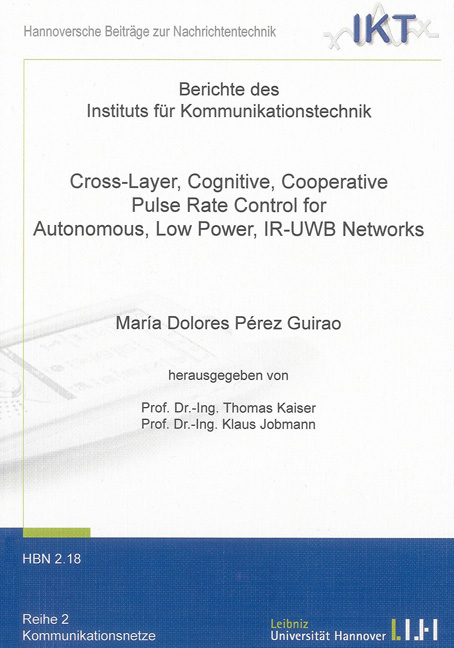
Cross-Layer, Cognitive, Cooperative Pulse Rate Control for Autonomous, Low Power, IR-UWB Networks
Seiten
2009
|
1., Aufl.
Shaker (Verlag)
978-3-8322-8034-5 (ISBN)
Shaker (Verlag)
978-3-8322-8034-5 (ISBN)
- Keine Verlagsinformationen verfügbar
- Artikel merken
Since the Federal Communication Commission (FCC) changed its spectrum management policy to encourage dynamic spectrum sharing, the demand for autonomous, cognitive wireless networks where devices opportunistically share the spectrum with minimal coordination and infrastructure has significantly increased. Particularly, in the context of low data rate (LDR), low power communications Impulse Radio Ultra Wideband (IR-UWB) is a key technology for such networks.
From a protocol design perspective, the main benefit of IR-UWB over narrowband radio technologies is the possibility to allow concurrent transmissions by using different pseudo-random, time hopping (TH) codes. However, TH codes are not perfectly orthogonal, and even if, due to asynchronicity between sources and multipath fading, Multi User Interference (MUI) is an issue.
Concerning MUI mitigation, the design of the MAC layer plays a very important role. When maximizing rates in LDR networks, the prevalent mind in the research community indicates that MUI should be combated by means of scheduling and rate adaptation. Particularly, for low power networks the optimal MAC layer design should follow an “all at once” scheduling and adapt the transmission rates to interference.
In IR-UWB networks, rate control can be achieved by adapting the channel coding rate, the modulation order or the processing gain. Regarding processing gain adaptation, and assuming that the energy per transmitted pulse is the same for all users, the reduction of the signal’s duty cycle by extending the “dead time” between pulses is preferable than to increase the number of pulses transmitted per symbol.
The main research effort in this thesis consists of the design of a novel, cross-layer, cognitive and cooperative approach for impulsive interference management. This enables concurrent transmissions at full power, while allows each source to independently adapt its pulse rate (transmitted pulses per second) to mitigate MUI. The design is independent of a particular modulation scheme or receiver technique. Furthermore, it can be combined with conventional adaptive channel coding. The approach is motivated by the fact that the distributed adaptation of IR-UWB processing gain has not been sufficiently addressed in the literature before. Existing approaches rely on the presence of a central authority or assume a definite receiver technique. This thesis focuses on autonomous networks; although hierarchical structures are not ruled out here, they are not required and therefore adaptation schemes must be performed at the end users.
From a protocol design perspective, the main benefit of IR-UWB over narrowband radio technologies is the possibility to allow concurrent transmissions by using different pseudo-random, time hopping (TH) codes. However, TH codes are not perfectly orthogonal, and even if, due to asynchronicity between sources and multipath fading, Multi User Interference (MUI) is an issue.
Concerning MUI mitigation, the design of the MAC layer plays a very important role. When maximizing rates in LDR networks, the prevalent mind in the research community indicates that MUI should be combated by means of scheduling and rate adaptation. Particularly, for low power networks the optimal MAC layer design should follow an “all at once” scheduling and adapt the transmission rates to interference.
In IR-UWB networks, rate control can be achieved by adapting the channel coding rate, the modulation order or the processing gain. Regarding processing gain adaptation, and assuming that the energy per transmitted pulse is the same for all users, the reduction of the signal’s duty cycle by extending the “dead time” between pulses is preferable than to increase the number of pulses transmitted per symbol.
The main research effort in this thesis consists of the design of a novel, cross-layer, cognitive and cooperative approach for impulsive interference management. This enables concurrent transmissions at full power, while allows each source to independently adapt its pulse rate (transmitted pulses per second) to mitigate MUI. The design is independent of a particular modulation scheme or receiver technique. Furthermore, it can be combined with conventional adaptive channel coding. The approach is motivated by the fact that the distributed adaptation of IR-UWB processing gain has not been sufficiently addressed in the literature before. Existing approaches rely on the presence of a central authority or assume a definite receiver technique. This thesis focuses on autonomous networks; although hierarchical structures are not ruled out here, they are not required and therefore adaptation schemes must be performed at the end users.
| Reihe/Serie | Hannoversche Beiträge zur Nachrichtentechnik ; 2.18 |
|---|---|
| Sprache | englisch |
| Maße | 148 x 210 mm |
| Gewicht | 218 g |
| Einbandart | Paperback |
| Themenwelt | Technik ► Elektrotechnik / Energietechnik |
| Schlagworte | Game Theory • Hardcover, Softcover / Technik/Elektronik, Elektrotechnik, Nachrichtentechnik • Interference Management • IR-MWB • Link Adaption • MUI |
| ISBN-10 | 3-8322-8034-0 / 3832280340 |
| ISBN-13 | 978-3-8322-8034-5 / 9783832280345 |
| Zustand | Neuware |
| Haben Sie eine Frage zum Produkt? |
Mehr entdecken
aus dem Bereich
aus dem Bereich
Kolbenmaschinen - Strömungsmaschinen - Kraftwerke
Buch | Hardcover (2023)
Hanser (Verlag)
49,99 €


